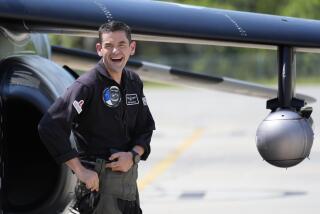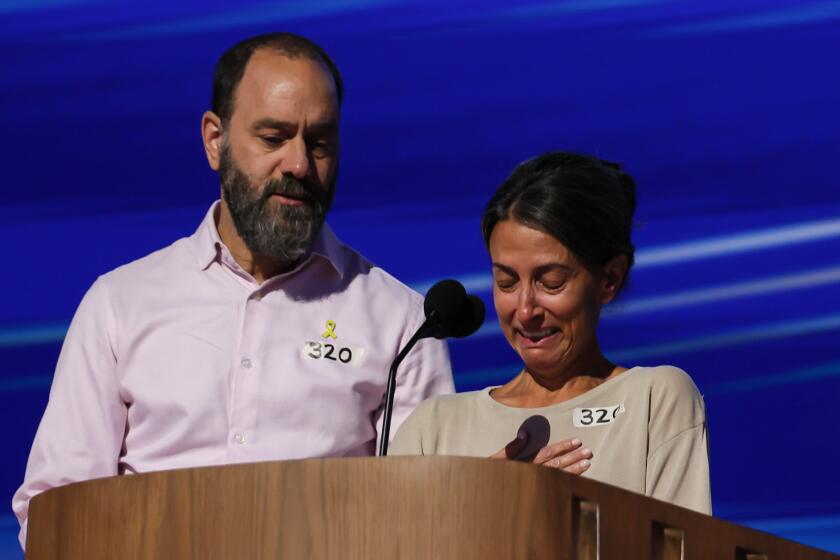Crew of 3 Blasts Off to Make a Home of Space Station
BAIKONUR, Kazakhstan — The first crew of what has been called the most ambitious international science project ever attempted, the $60-billion International Space Station, blasted off on its four-month mission today from this frigid Russian base in the wastes of Kazakhstan.
From the same pad used by the first Sputnik in 1957 and Russian cosmonaut Yuri A. Gagarin, who opened the era of manned space flight in 1961, a slender Soyuz TM-31 launch vehicle started an American and two Russians on a voyage that could represent the beginning of humanity’s permanent habitation of space.
Agreed upon by the U.S. and Russian governments in 1993 and under construction since 1998, the project has become the primary focus of both countries’ space programs.
Expedition I is commanded by Navy Capt. William Shepherd, 51, who has flown three previous U.S. space shuttle missions. His crew consists of Russian air force Lt. Col. Yuri Gidzenko, 38, who was to pilot the Soyuz launch vehicle into orbit and dock it 48 hours later with the space station 221 miles above Earth, and Russian flight engineer Sergei Krikalev, 42, a veteran of four Russian and U.S. space missions. Krikalev is one of the world’s most experienced space travelers, having logged 484 days in orbit.
The astronaut and two cosmonauts have been training in each other’s language since 1996. They plan to speak a polyglot they call “Runglish” and eat both Russian and American foods during their mission. As the space station’s first crew, their job will be to turn on computer and navigation systems, assist in expansion of the station and establish everyday procedures--in short, to bring it to life.
“It’s definitely the beginning of a new era in human spaceflight,” said NASA official Mike Baker. “From now on, all human endeavors in space will be joint.”
“They’ll be taking care of this home and making it a good home for the next group,” said Canadian astronaut Julie Payett, who is in Baikonur to provide support for the mission and help prepare a shipment of provisions scheduled for next month.
Although it is already 140 feet long and weighs about 80 tons, the space station remains very much a work in progress.
Dozens more construction missions are anticipated in the next five years. The space station will gradually expand until it weighs about 1 million pounds and is both longer and wider than a football field. Huge solar panels will generate more than 60 times the power for experiments than on the existing Russian orbiter Mir. In the future, the station will be home to as many as seven astronauts at a time.
The station is designed to remain operational for at least 15 years and perhaps as long as 25 years. Its laboratories are expected to contribute vital knowledge about the effects of microgravity and long-term living in space, lessons that could lay the foundation for new drug discoveries or a possible future manned voyage to Mars.
Under the original timetable, the station should have received its first crew 2 1/2 years ago. But the project fell behind because of Russia’s financial collapse, which slowed delivery of the station’s first living module, and problems with its Proton rocket.
Asked at a prelaunch news conference how he felt to be finally embarking on a mission for which he began preparing about five years ago, Shepherd answered crisply: “I’m anxious to get started.”
After years of training, all three crew members said that they had already transcended any cultural divisions among them. “We don’t even need to talk to each other sometimes--we just take a look at each other and we have got it,” Gidzenko said.
There have been some hurt feelings among Russians that the initial command would go to an American with much less time in space than his counterparts.
One veteran Russian cosmonaut originally selected for the crew removed himself in 1996 rather than serve under Shepherd. Krikalev said in a newspaper interview in Russia last week that he considered the idea of a commander in a three-person spacecraft irrelevant and that they would function more like partners.
Speaking to reporters Monday, Krikalev said he is convinced that everything will be fine. “We work as one team now, and it no longer matters who of us, a citizen of which country, is the commander.”
He added that in the space station’s present state, life aboard would be tough--with a heavy workload, quarters more cramped than the nearly 15-year-old Mir and a U.S.-designed toilet that does not work as well as one of Russian design.
With so much to be done, Shepherd said his biggest challenge might be to restrain the Russians from working too aggressively at first. “My job is to make sure that the crew stays on an even keel and gets its work done [but] without really tiring ourselves out,” he said.
The advantage of the new space station for the United States--which is leading the 16-nation project with contributions from Brazil, Japan, Canada and 11 nations of the European Space Agency--is that it now has an ongoing venue in which to conduct experiments in space.
For Russia, the space station provides a chance to continue and expand the research begun on Mir, now vacant and likely--unless new government or private funds miraculously appear--to be brought down into the Pacific Ocean in February.
Some Russians have been reluctant to move beyond Mir, which despite its problems remains a great source of national pride. Some Russian politicians have voiced fear that Russia will be relegated to the role of a junior partner in the new station.
Yuri P. Semyonov, designer-general of the Energiya Corp., which built Mir and most of Russia’s other important rockets and space vehicles, alluded to his own mixed feelings at the ceremony to send off the crew.
“If we get this mission up and running, it will make it easier for us to bid farewell to the Mir station,” he said.
The Expedition I crew was being sent into space by one of the oldest and most reliable Russian rockets, the Soyuz, which in various versions has had more than 1,600 launches since the 1950s. The three-stage rocket is fueled by liquid oxygen and kerosene.
Thin and elegant, the shiny, arrow-shaped launch vehicle was rolled out of its hangar in a dawn fog Sunday on a flatbed railroad car and transported 1.5 miles to the launch pad. Less than two hours later, it already had been lifted to its vertical position as a bevy of Russian generals, journalists and the backup crew watched.
For the first time in the memory of journalists covering such a launch, a manned rocket was emblazoned with no flags or national insignia. Instead, it carried the name Dreamtime, an Internet company that intends to archive and distribute space video and photographs. The paid advertisement symbolized Russia’s ongoing financial challenge to keep its tattered but proud space industry functioning.
The space station began to take shape in December 1998 when the Russian-built Zarya and the U.S.-made Unity modules were mated in the initial assembly flight. The Russians delivered the Zvezda living module to orbit in July, six months behind schedule, clearing the way for the first crew to take possession of the station.
The Russians’ formerly top-secret Cosmodrome now appears somewhat ramshackle, with unpainted or peeling buildings, broken windows and rusting smokestacks spread out across the scrubland of Kazakhstan, which became an independent country in the breakup of the Soviet Union.
Asked if she was disquieted by what she saw, Beth Stringham-Shepherd--a NASA fitness trainer and wife of the space station commander--said looks were deceiving.
“Look at their program,” she said. “They’ve been very, very successful.”
The mission has its roots in a call made by President Reagan for an international space station in his 1984 State of the Union address. But when the 1986 explosion of the space shuttle Challenger grounded shuttle missions for two years, the space station lost priority. It regained momentum after the collapse of the Soviet Union led President Clinton to invite Russia to join, in part to help Moscow shore up its economy, in part to gain access to Russian expertise and experience and to share the cost.
The countries plan an ambitious series of launches and construction in the coming four months, including three unmanned supply vehicle dockings and three visits from U.S. shuttles. Shepherd, Gidzenko and Krikalev are scheduled to return to Earth by shuttle in February, and a new three-man crew, this time with a Russian commander and two Americans, would take over.
NASA flight director John M. Curry told reporters last week in Houston that the launch might someday be remembered as the beginning of permanent human habitation off the surface of Earth.
“I’d say there’s a decent chance that Oct. 30 may, in fact, be the last day we don’t have humans in space,” he said.
*
Alexei V. Kuznetsov of The Times’ Moscow Bureau contributed to this report from Baikonur.
More to Read
Sign up for Essential California
The most important California stories and recommendations in your inbox every morning.
You may occasionally receive promotional content from the Los Angeles Times.










